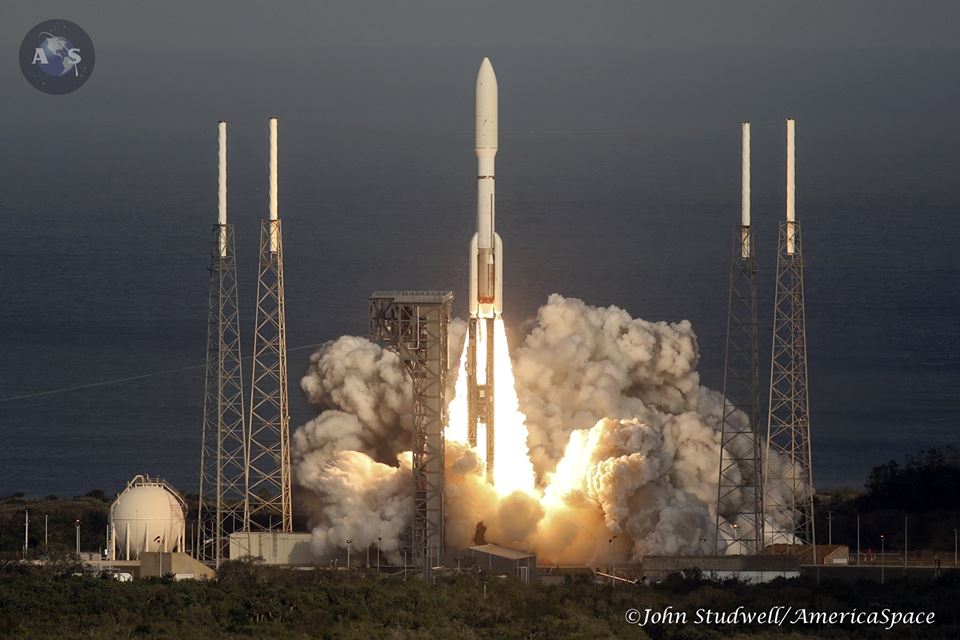
Picking up the baton for what is expected to be one of its busiest years on record, United Launch Alliance (ULA) has successfully delivered the NASA/NOAA’s latest Geostationary Operational Environmental Satellite—initially known as “GOES-S”, but numerically redesignated “GOES-17” when it enters active service—into orbit from Space Launch Complex (SLC)-41 at Cape Canaveral Air Force Station, Fla.
Liftoff of ULA’s rarely-used Atlas V 541 rocket, with a 17-foot-wide (5-meter) Short Payload Fairing (SPF), four strap-on solid-fueled boosters and a single-engine Centaur upper stage, occurred on time at 5:02 p.m. EST Thursday, 1 March, right on the opening of today’s two-hour “window”. From its orbital position at an altitude of about 22,300 miles (35,900 km), the Lockheed Martin-built GOES-S will mark the second member of the fourth generation of spacecraft which have revolutionized our understanding of the Home Planet since the 1970s.
Video Credit: NOAA
It was ULA’s third launch of 2018, following on from the classified NROL-47 payload for the National Reconnaissance Office and the latest geostationary-orbiting element of the Space-Based Infrared System (SBIRS GEO-4), both of which flew in January. Coming up for the Centennial, Colo.-headquartered launch services organization after GOES-S are six more Atlas V flights to deliver three military communications satellites to orbit, NASA’s InSight lander towards Mars—marking the first voyage to the Red Planet staged out of Vandenberg Air Force Base, Calif.—and the initial unpiloted and crewed missions by Boeing’s CST-100 Starliner vehicle.
Rounding out ULA’s 2018 manifest are as many as four more Delta launches, including the final flight of the workhorse Delta II and not one, but two missions by the gigantic Delta IV Heavy to loft NASA’s Parker Solar Probe and the classified NROL-71 payload. Flown nine times since December 2004, the Heavy now stands as the second-highest-capacity booster in the world, after the recently-trialed Falcon Heavy, and its twin 2018 launches will mark its greatest number of uses in a single calendar year. All told, ULA aims to fly as many as 13 times in 2018, tying with 2007, but falling shy of it peak 16 launches in 2009 and 14 launches in 2014.
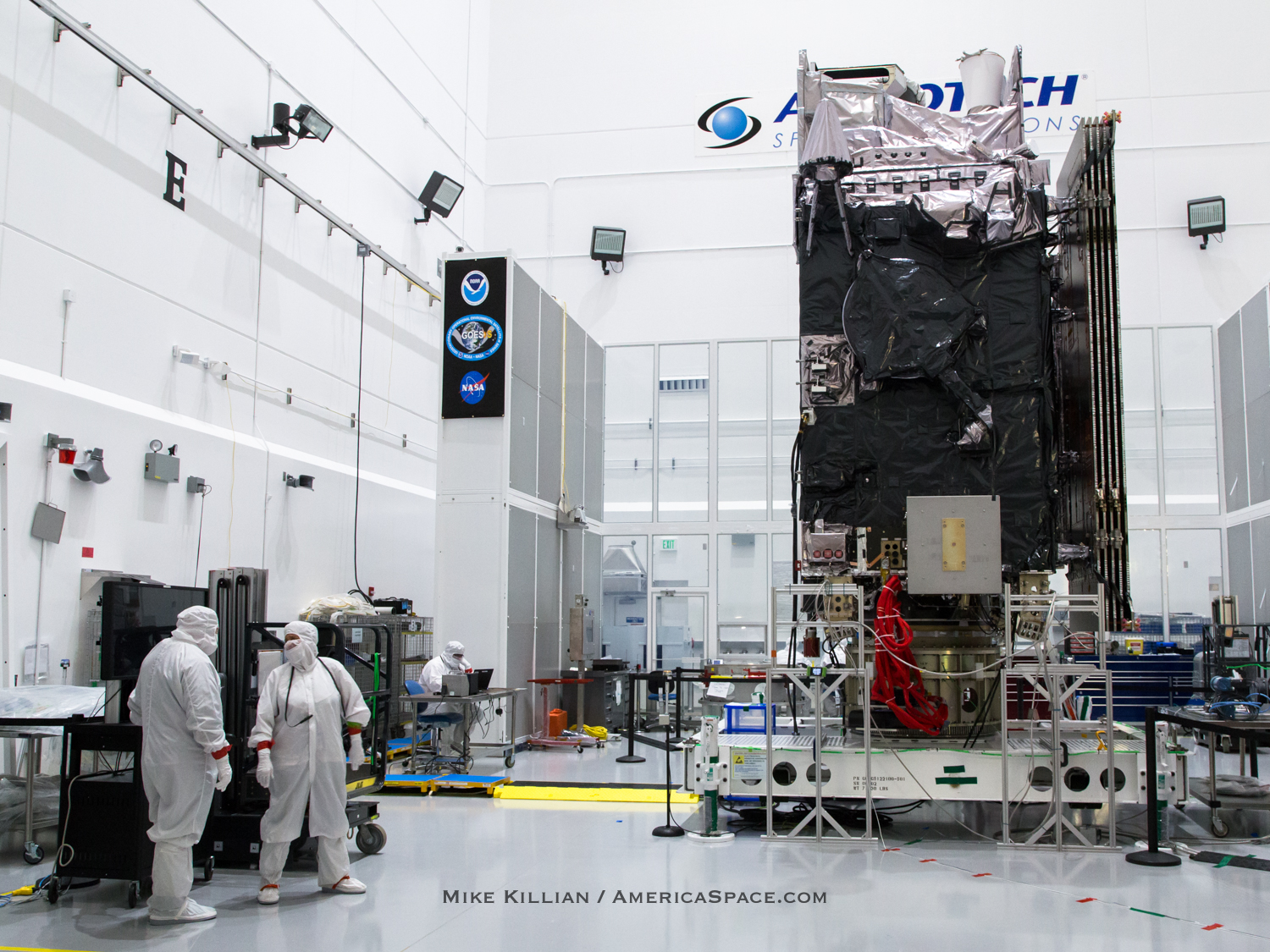
Operated by the United States’ National Environmental Satellite, Data and Information Service (NESDIS), the multi-spacecraft GOES network is responsible for weather forecasting, storm tracking and meteorological research from geostationary orbit. It became customary for each satellite to be identified via a letter of the alphabet, before launch, and renamed with a number after entering service. Consequently, GOES-S will be numerically redesignated “GOES-17” when it begins operations. GOES-S marks the second member of the fourth generation of the fleet, following on from the launch of GOES-16 in November 2016.
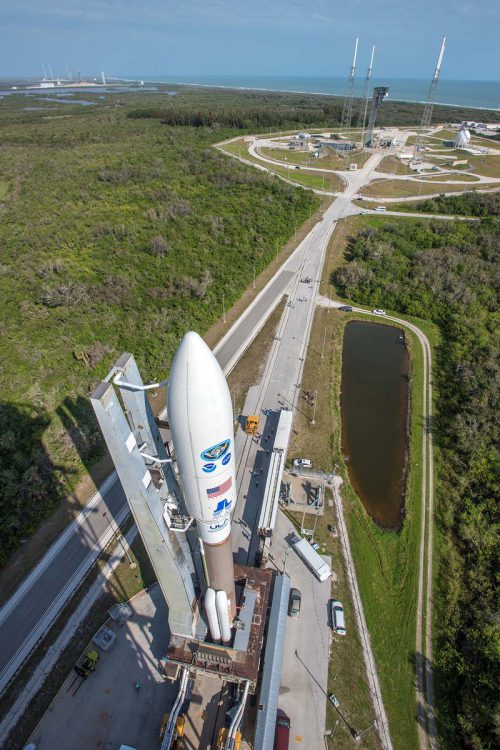
Contracts to build the instruments for the fourth-generation GOES were awarded back in 2006 and Lockheed Martin was selected by NASA in December 2008 to build and integrate a pair of spacecraft, at an estimated cost of $1.09 billion. In April 2012, it was announced that ULA would deliver the GOES-R and GOES-S satellites into orbit, with initial target launch dates of October 2015 and February 2017. However, these dates slipped to the right and GOES-R eventually flew in November 2016.
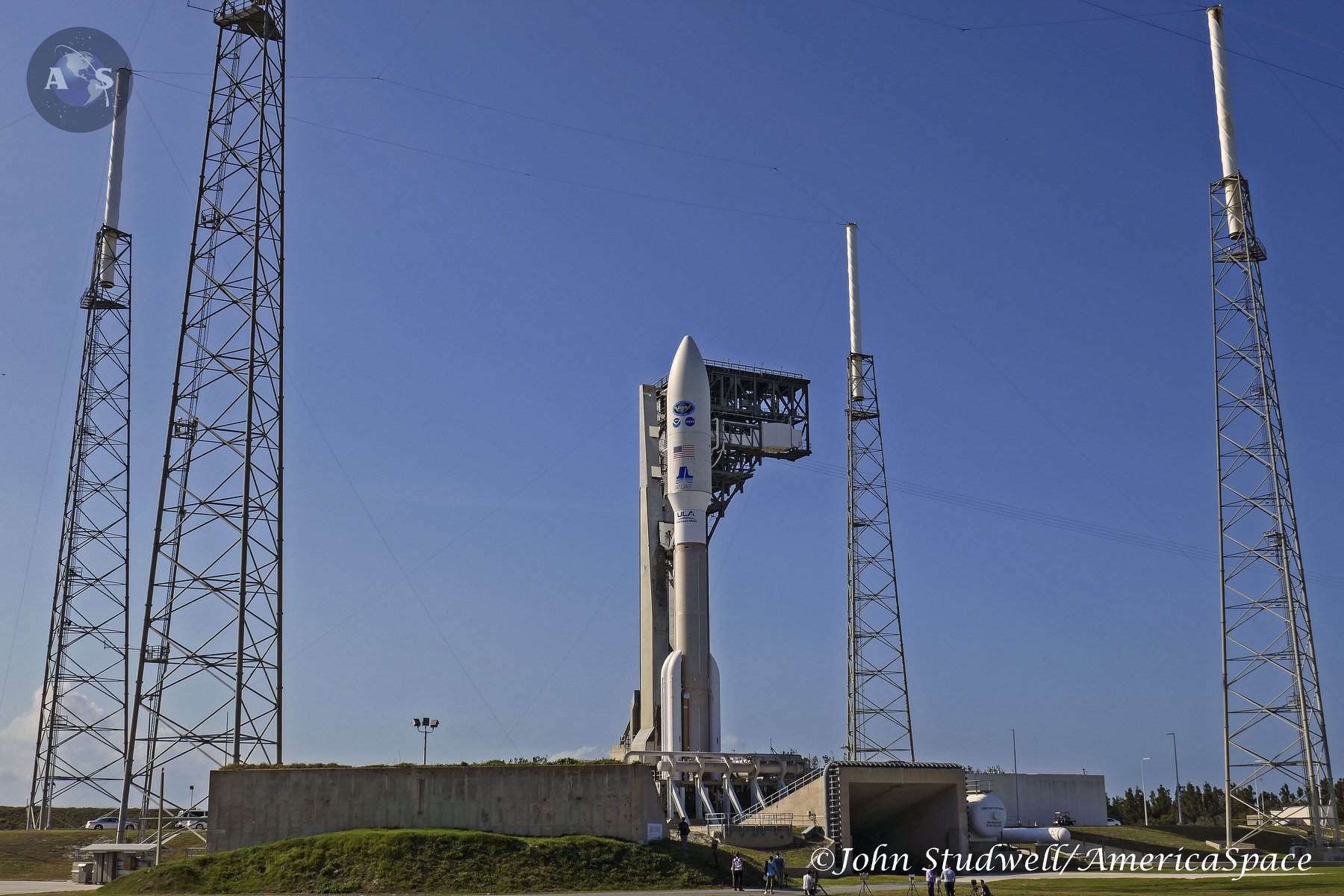
Last December, the satellite was delivered from Buckley Air Force Base in Aurora, Colo., to the Kennedy Space Center (KSC), aboard an Air Force C-5M Super Galaxy heavylift transport aircraft, for final pre-launch processing.
In January, GOES-S underwent fueling in the Astrotech Space Operations clean room in Titusville, Fla., and the Common Core Booster (CCB) of its Atlas V launch vehicle arrived at the Army Wharf at Cape Canaveral Air Force Station on 22 January, via the Mariner transport ship. The 106.6-foot-long (32.5-meter) CCB was transferred to the Atlas Spaceflight Operations Center, close to the SLC-41 launch site. Two days later, on the 24th, the rocket’s Centaur upper stage arrived and entered directly into processing at the Delta Operations Center. By 31 January, the CCB had been raised at the Vertical Integration Facility (VIF) at SLC-41, setting the groundwork for the installation of the four side-mounted solid-fueled rocket boosters.
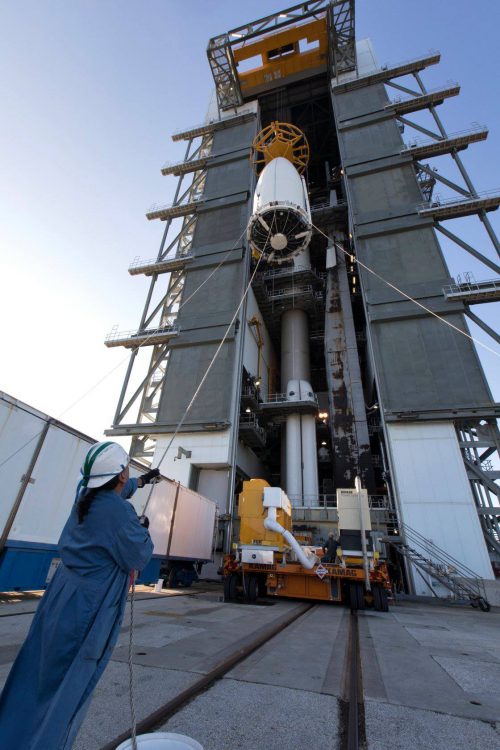
By the second week of February, GOES-S had completed fueling and was encapsulated within its 17-foot-wide (5-meter) Short Payload Fairing (SPF). On the 17th, ULA CEO Tory Bruno tweeted that it had been integrated atop the Atlas V, raising the height of the stack to an estimated 197 feet (60 meters). “#GOES-S is now resting upon the shoulders of Mighty Atlas,” Mr. Bruno noted. Over the next few days, integrated systems tests were performed on the spacecraft and launch vehicle, culminating in a successful Flight Readiness Review (FRR) on the 23rd.
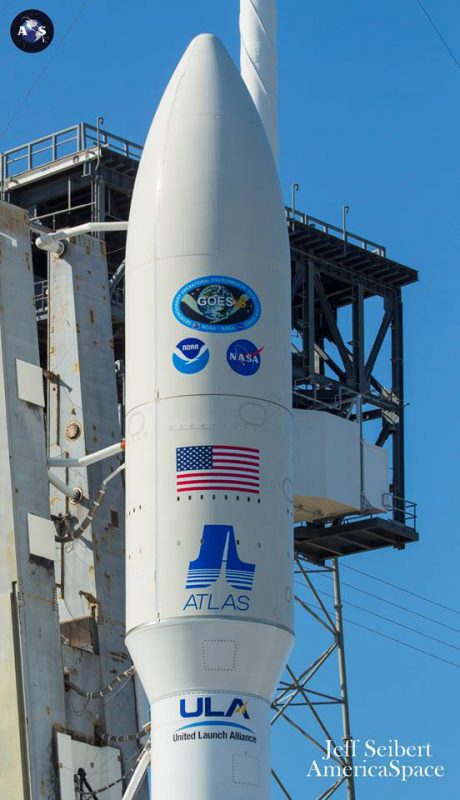
For today’s flight, the Atlas V flew in the rarely-used “541” configuration, its second-most-powerful variant. In addition to its 16-foot-wide (5-meter) fairing, it is equipped with four side-mounted, solid-fueled rocket boosters and a single-engine Centaur upper stage. The 541 previously flew five times between November 2011’s launch of the Mars Science Laboratory (MSL) and Curiosity rover and last September’s NROL-42. It carries the potential to deliver 38,450 pounds (17,440 kg) into low-Earth orbit and up to 18,270 pounds (8,290 kg) to geostationary altitude. Upcoming uses of the 541 include NASA’s Mars 2020 rover, currently targeted to launch in July 2020.
With the bulbous SPF capping-off the stack, the Atlas V 541 looked comically top-heavy as it was rolled the quarter-mile (400-meter) distance from the VIF to the SLC-41 pad surface on Wednesday. When the vehicle was “hard-down” on the pad, it was carefully centered and propellant umbilicals and electrical and data connections were established. The track mobiles from the Mobile Launch Platform (MLP) were removed and ULA engineers set to work preparing for formal countdown operations, tracking a T-0 at 5:02 p.m. EST Thursday, at the opening of a 120-minute “window”.
Weather conditions for both the primary launch attempt on Thursday and a backup opportunity on Friday were predicted to be 80-percent favorable, tempered by the risk of violating the Cumulus Cloud Rule and Ground Winds Rule. “On Launch Day, the next frontal boundary pushes into the Florida Panhandle during the count and near the Big Bend area during the window,” the 45th Weather Squadron at Patrick Air Force Base noted in its L-3 briefing on Monday. “Relatively dry conditions persist over Central Florida on Launch Day, in advance of the front, with a slight threat of an isolated shower with late-day diurnal heating. The primary concern for launch is cumulus clouds and strengthening ground winds.” In the event of a 24-hour scrub and turnaround to Friday, it was stressed that the main concern would be cumulus clouds. Launch Readiness Review operations were concluded late Tuesday, 27 February.
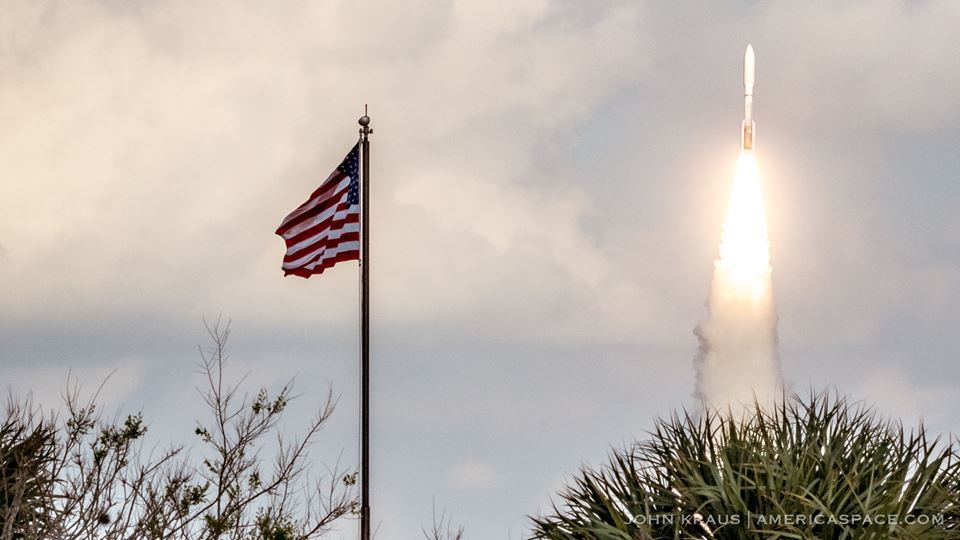
Moving into Thursday’s opening attempt, the ULA team initiated flight control systems, brought command, control and communications instrumentation online and verified interfaces between the Atlas V and the Launch Control Center (LCC). “Bird is on the pad,” tweeted ULA CEO Tory Bruno. “#GOES is healthy. Weather looks good. Feels like a good day to go to space.”
The Atlas V’s Russian-built RD-180 engine roared to life at T-2.7 seconds, quickly ramping up to its full 860,000 pounds (390,000 kg) of propulsive yield. At zero, the four side-mounted solids ignited, punching the 1.2-million-pound (540,300 kg) rocket off SLC-41 with a combined thrust in excess of 2.3 million pounds (1.07 million kg). Passing Mach 1 at 35 seconds into the flight, the vehicle encountered a period of maximum aerodynamic turbulence (known as “Max Q”) on its airframe shortly thereafter. The four boosters, each measuring 55.7 feet (17 meters) long, burned for about 110 seconds, before separating in pairs, with each separation event timed 1.5 seconds apart.
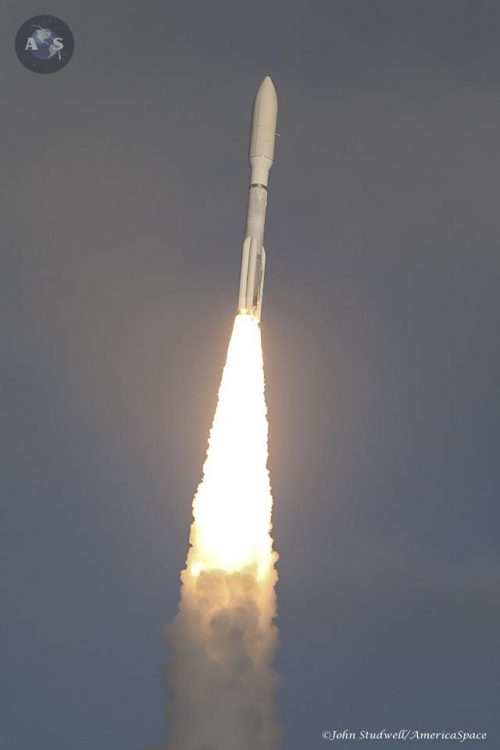
With the boosters gone, the Atlas V continued powering uphill under the raging thrust of the RD-180. At 3.5 minutes into the flight, the SPF was jettisoned, exposing GOES-S and the attached Centaur upper stage to the space environment for the first time. Finally, the RD-180 shut down at 4.5 minutes and the vehicle coasted for a few seconds, before the CCB was discarded. The stage was now set for no fewer than three “burns” by the Centaur’s restartable RL10C-1 engine, which would enable the separation of the GOES-S payload at just under three hours and 32 minutes into the flight.
The satellite’s orbital parameters at separation were predicted to carry an apogee of 21,925 miles (35,286 km) and a perigee of 5,100 miles (8,215 km), inclined 9.52 degrees to the equator. Over the next several months, GOES-S will undergo an extensive period of checkout, preparatory to around a decade of operational service.
FOLLOW AmericaSpace on Facebook!
Missions » GOES-R »



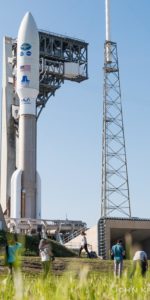
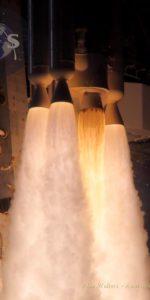
Thank you so much for this!
Thank you po. God bless you mabuhay po kayo.